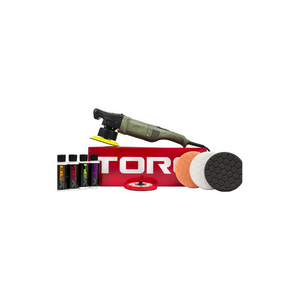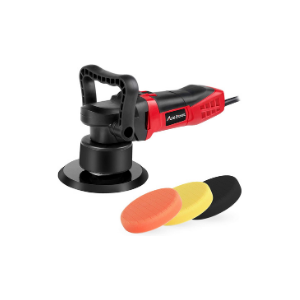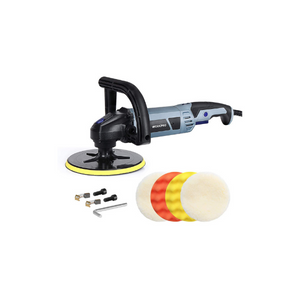
Is your car no longer shining like it used to, even after washing and removing water spots and stains? Simply washing and cleaning isn’t enough to restore your car’s original luster.
To bring back that shine, polishing and waxing your car’s paint is essential. The best way to do this is by using a buffer, which is an affordable, quick, and user-friendly tool. Buffing not only removes oxidation, swirl marks, tar, bugs, and acid rain etching but also eliminates deep and light damage caused by daily driving and sun exposure—without harming the paint.
Regular exposure to sunlight and environmental elements can dull your car’s finish, leaving it looking worn. Buffing effectively restores its appearance, giving it a fresh, showroom-quality shine.
Cartoolsguide will walk you through how to polish your car with a buffer and what to look for when buying one.
While it’s possible to polish your car by hand, you can only remove minor scratches and swirls this way. For deeper scratches, machine polishing is necessary to achieve the best results. Using a buffer is much faster and easier, and it prevents your arm muscles from getting sore.
When shopping for a buffer, choose a reliable brand with good reviews. Look for a buffer with a speed range of 600 rpm to 3000 rpm, as this is the recommended range by professionals. If you’re a beginner, start with a slower speed and gradually increase it as you get comfortable.
Another important factor is the size of the “throw” of the buffer, which refers to the size of the orbit the buffer covers while polishing. A larger throw means faster polishing but can be harder to control, especially for beginners. Make sure the buffer feels comfortable in your hand and isn’t too heavy.
While there are cheaper buffers available, be cautious. Cheap models tend to break after one use. It’s better to invest in a quality buffer that will last longer, even if it costs a bit more. Before buying, try the buffer on a small damaged area to see how it performs.
For beginners, an orbital buffer is recommended, while more experienced detailers may prefer a rotating buffer. Orbital buffers are designed to slow down and stop, making them easier to control.
When it comes to polishing, you’ll use microfiber pads, also known as “bonnets.” The type of pad you choose and the polishing compound you use depend on the level of damage to your car’s surface. For more severe damage, choose a stiffer pad and a more aggressive compound. Apply a small amount of polishing compound to the pad and spread it over a 2ft by 2ft area before turning the buffer on.
Using a finer compound will make the process smoother, reducing the chance of scratching the paint. Generally, 5-6 pads are needed for small vehicles, while 7-8 pads are required for larger vehicles.
With the right buffer and technique, you can restore your car’s shine and protect its paint for years to come.
How to polish a car with a orbital buffer
Table of Contents
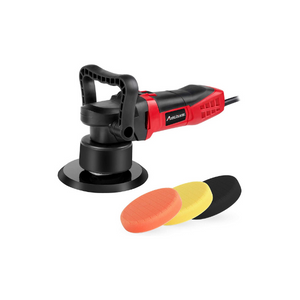
Machine polishing is the most efficient way to polish and wax your vehicle’s paint compared to doing it by hand. While it offers a quick and complete shine, it’s not as simple as it sounds. There are important techniques you must follow to ensure safe and effective polishing.
Your car’s paint consists of three main layers: the Primer, Base Color Coat, and Clear Coat. The Clear Coat is the thinnest layer, protecting the base coat from oxidation and scratches. However, if you’re not careful, over-polishing the clear coat can lead to scratches and damage.
To avoid this, you must learn how to use the buffer properly—like the right speed, pressure, how long to polish an area, and how to move the machine. If you’re a beginner, these questions can be confusing. That’s why we recommend starting with a dual-action polisher or random orbital buffer. It’s easier to use because it automatically slows down or stops if too much pressure is applied, helping you avoid mistakes.
Here’s how to polish your car with an orbital buffer in the easiest way:
1. Wash Your Car First
Before you start polishing, it’s crucial to wash your car. The surface may have small debris or particles that can scratch your paint during polishing. Use warm, soapy water—marine soap is a great choice for car washes. Apply it with a sponge or clean cloth, rinse, and dry it using a microfiber towel. Check carefully to ensure no debris is left behind.
2. Apply Polishing Compound to the Buffer Pad
Polishing compound is used to clean and shine your car’s paint. It removes light scratches, watermarks, and oxidation. For more severe scratches, a rubbing compound may be necessary. Consult with a professional to choose the right polish for your car’s needs.
Apply a few drops of polishing compound to the center of your buffer pad. Don’t spread it across the entire pad. Turn the buffer on and let it run for 5-10 seconds to evenly distribute the compound before placing it on your car.
3. Turn on the Buffer and Start Polishing
Before you start polishing, it’s a good idea to practice on an inconspicuous area, like the trunk lid, to get comfortable with the buffer. Hold both the front and back handles of the buffer firmly and apply light pressure to avoid scratching your paint.
Start with a low speed (RPM), as this generates less heat and friction. It’s safer for the paint. Gradually increase the speed as you move from one panel to another. Keep the speed between 1750-2400 RPM for the bulk of the panel, then lower it to 1200-1750 RPM as you finish up.
4. Move the Buffer Gradually
When using the buffer, follow a systematic pattern. Start from one side of the vehicle and move the buffer slowly across, from right to left or left to right. At each stroke, change the direction of the buffer—top to bottom or bottom to top—so the polish is even.
Be sure not to linger in one spot too long, as that could cause scratches. Move steadily and keep an eye on the pressure and speed. If you still notice swirl marks or feel that the shine isn’t as good as you’d like, you may need to re-polish.
5. Polish in Small Sections
To achieve the best finish, divide your car’s surface into 2ft x 2ft sections. Apply one drop of polish to each section and polish each one at a time. This ensures an even and glossy result.
6. Wipe Off Residue
Once you finish polishing, use a clean microfiber towel or cloth to wipe off any remaining polish residue. This step ensures your car’s paint has a smooth, shiny finish.
By following these simple steps, you’ll get that fresh, glossy shine without the worry of damaging your car’s paint.
How to polish a car with a rotary buffer
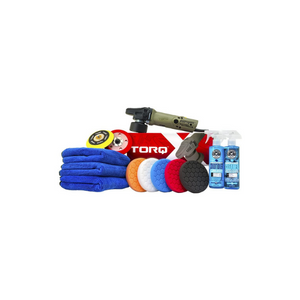
A rotary buffer is a powerful polishing tool designed to fix serious paint issues like deep scratches, blemishes, oxidation, tough stains, and discoloration. It helps give your car’s paint a glossy, glass-like finish much faster than a dual-action (DA) polisher, but it only spins in one direction.
Unlike DA polishers, which rotate in two directions, a rotary buffer spins in one direction at a higher speed. This makes it highly effective for correcting severe paint defects, but it also requires careful handling and skill.
Although rotary buffers are fast and efficient, they can be risky if not used properly. The higher speed can generate heat, which could burn your car’s paint if you’re not careful. This makes rotary polishers better suited for experienced detailers. But don’t worry! If you follow our tips, using a rotary buffer can be easy and safe.
Here’s a simple guide to polishing your car with a rotary buffer:
1. Start at Low Speed
Always begin at a low speed to avoid damaging your paint. High speeds can cause heat buildup, leading to deep scratches or even burning your car’s clear coat. Stay within the 1000-1200 RPM range and never exceed 1800 RPM. You can gradually increase the speed if necessary.
2. Keep the Buffer Moving
Make sure to keep the buffer moving across your car’s surface. Stopping in one spot for too long can cause severe damage, including burning through the clear coat. Avoid using circular motions—this can heat up your car’s paint too quickly. Instead, move the buffer back and forth or side to side.
3. Avoid Edges and Corners
Be cautious around the edges and corners of your car’s panels, as the paint is usually thinner in these areas. Polishing too aggressively here can damage the paint.
4. Keep the Pad Flat
Always keep the pad flat against your car’s surface. Tilting the back of the pad slightly upwards will help prevent the buffer from dragging across the paint, which could result in unwanted holograms.
5. Wax After Polishing
Many detailers prefer to finish up by waxing the car with a DA polisher. This gives your car a perfect, shiny finish. If you want the best results, you can also apply wax with a rotary buffer.
6. Consider Professional Help
If you’re still unsure about using a rotary buffer or lack confidence, it’s a good idea to choose a DA polisher, which is safer for beginners. Alternatively, you can hire a professional to do the job with a rotary buffer.
By following these tips, you can safely use a rotary polisher to restore your car’s paintwork to its former glory. With practice, you’ll achieve a smooth, glossy finish without risking damage to your paint.
How to polish and wax a car with a buffer
Car wax is a thin, soft layer that sits on top of your car’s paint, providing a hydrophobic barrier to protect your car from the elements. It shields the clear coat from UV rays, sunlight, rain, road spray, and more, while giving your car a shiny, glossy finish. Think of it like sunscreen for your car—keeping it protected and looking great!
Applying wax to your car can be done by hand or with a machine. Using a buffer or polisher for waxing is quicker and easier than doing it by hand, especially if you want to save time. If you’re wondering how to wax a car with a buffer, follow these simple steps for a flawless finish:
Materials You’ll Need:
- Liquid wax
- Microfiber towel
- Waxing pad
- Wax removal cloth
- Machine buffer
Step 1: Choose a Shaded Area
Avoid waxing your car under direct sunlight. Wax dries quickly in the sun, which can cause uneven application. It’s best to work in a shaded area, like a garage, where you can control the environment and work comfortably.
Step 2: Wash Your Car
Before applying wax, make sure your car is clean. Wash off any dirt or debris to avoid scratching the paint while waxing. It’s also a good idea to polish your car after washing to ensure it’s spotless, but if you’re in a hurry, just washing will do.
Step 3: Apply the Wax and Buff
- Apply a small amount of liquid wax to your waxing pad.
- Gently apply the wax to your car’s surface, either horizontally or vertically. Avoid using circular motions, as this can cause swirl marks.
- Attach the waxing pad to your buffer and place it gently on your car’s surface. Turn the buffer on to start working.
- Use light pressure and move the buffer steadily over the car, allowing the wax to spread evenly. Glide the buffer across the surface with each stroke, avoiding staying in one spot too long.
Step 4: Remove Residue
Once you’ve finished buffing, check for any leftover wax residue. Use a microfiber towel or wax removal cloth to wipe off any excess and leave your car with a beautiful, shiny finish.
Final Tip:
Machine waxing gives your car a smooth, professional-looking finish much faster than hand waxing. Plus, it provides better protection from the elements, keeping your car looking newer for longer!
By following these simple steps, you can easily wax your car with a buffer and give it a sleek, glossy shine that lasts.
Why should you use Dual Action Polisher to polisher your car?
Hand polishing your car can be time-consuming and often doesn’t give you that showroom-like shine you’re hoping for. So, why not consider using a dual action polisher to achieve a perfect finish?
A dual action (DA) polisher might cost a little more than hand polishing, but it’s worth every penny. It delivers impressive results, providing a smoother, shinier finish and helping you restore your car’s original shine. Unlike a rotary polisher, which can be tricky to handle and requires experience, the DA polisher is safe, user-friendly, and perfect for both beginners and professionals.
Benefits of Using a DA Polisher:
- Removes Swirl Marks and Scratches: It helps eliminate small imperfections like swirl marks and light scratches, giving your car a smoother surface.
- Improves Texture and Luster: A DA polisher enhances your car’s texture, making the paint look vibrant and shiny, much better than hand polishing.
- Safe to Use: Unlike rotary polishers, which can be risky and may cause damage if not used properly, the DA polisher is easy to control and safer for your car’s paint.
However, it’s important to note that a DA polisher won’t repair deep scratches or provide the same level of smoothness and shine as a rotary polisher. But for general polishing, it’s the perfect tool.
If you’re looking for a quick and effective way to make your car’s paint shine without risking damage, a dual action polisher is the way to go.
Difference Between Dual Action Polishers and Rotary polishers
- A Dual Action (DA) polisher is much safer to use than a rotary polisher. While rotary polishers spin in just one direction, they build up heat quickly, which can potentially burn your car’s paint. In contrast, a DA polisher moves in two circular directions, making it much gentler on the surface and ensuring you get a smooth, mirror-like finish without the risk of damaging your car’s paint.
- One of the key benefits of the DA polisher is that it allows you to control the speed. Many DA polishers come with variable speed settings, so you can adjust the speed according to your needs. This flexibility gives you the confidence to polish at your own pace, without worrying about over-heating or burning the paint.
- The DA polisher is excellent for removing minor imperfections, like light scratches, swirl marks, and etching. It restores the shine of your car, leaving it looking glossy and well-maintained for months. Its vibration motion and automatic speed adjustment help make polishing easy and safe, even for beginners. If you apply too much pressure, the machine automatically adjusts to prevent damage, which makes it a user-friendly tool for anyone new to detailing.
- On the other hand, a rotary polisher works faster and can correct more serious imperfections, like deep scratches. However, it requires a skilled hand, as the risk of burning through the paint is higher due to its single-direction spin and higher speed.
- For beginners, a DA polisher is the safest and easiest tool to use. It eliminates small imperfections like scratches and swirl marks while being gentle on your car’s paint. With its automatic adjustments and smooth operation, the DA polisher ensures your car gets the perfect finish, without the fear of making mistakes.
- In short, if you’re just starting out in car detailing, the DA polisher is the perfect choice. It’s safe, easy to control, and still delivers amazing results, while a rotary polisher is best left to experienced detailers.
Best Dual Action Polisher for Beginners
As a beginner, a DA polisher is the best choice for polishing your car. It’s safe, easy to use, and perfect for getting that shiny, glossy finish. However, with so many options available, it can be tricky to choose the right one for your needs.
Different DA polishers are designed for different tasks—some are ideal for flat paint surfaces, while others are built to handle narrow curves, headlights, or other tricky areas. Key features to consider when buying a DA polisher include its speed, weight, throw (the size of the oscillation), and safety features.
It’s important to find a DA polisher that meets your specific needs. You’ll want one that not only provides the perfect shine but also is easy to handle, fits your budget, and works well for the type of car you have.
To help you make the best decision, we’ve compiled a list of popular DA polishers that are loved by beginners. These polishers offer great performance, ease of use, and excellent results, making them the perfect choice for anyone just starting with car detailing.
BLACK+DECKER Random Orbit Polisher Review
This Dual Action polisher weighs around 2.05 pounds which is easily lifted and move on your car’s surface. Its ergonomic design with two handles and 10ft long cord will comfort you in polishing.
This polisher is most suitable for beginners as it is featured with 6 variable speed ranges from which you can select your favorable speed and is used for both polishing and waxing. The diameter of polishing wheel is 7 inches that provides you a large throw by which the polishing can be finished fast.
Autocare Car Dual Action Polisher Review
This is also a beginner-friendly dual action polisher which is 5.65 pounds in weight, equipped with 6 variable speed ranges and a detachable side handle for which you will feel easy when polishing. The special feature of this polisher is planetary gear group technology which will give you the best performance with less power consumption and lower noise.
Conclusion
Hope, our website has given all the answer of your queries about how to polish a car with a buffer. I hope after reading this article you are going to enjoy glass like shine from your car.
